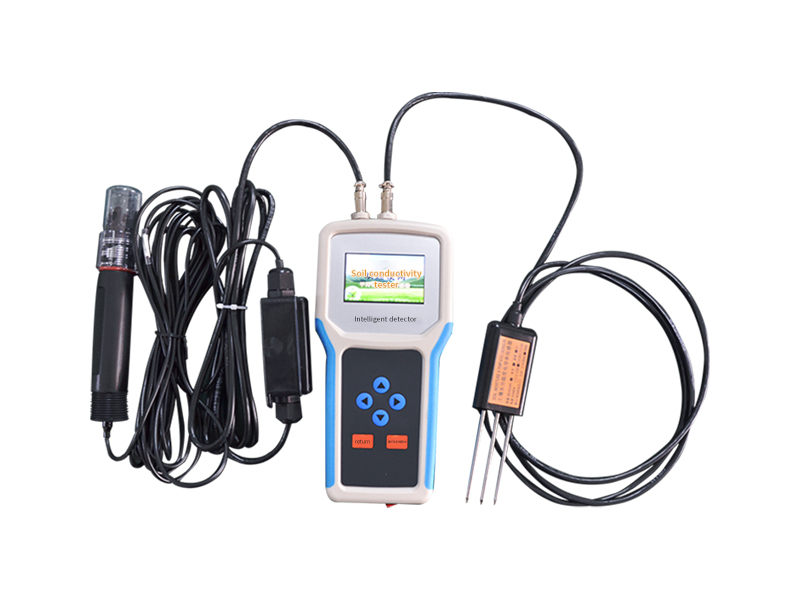Soil salinization is an important issue that affects agricultural production, ecological environment, and sustainable land use. The traditional soil salinity detection method requires laboratory chemical analysis, which has limitations such as cumbersome processes, long time consumption, and inability to quickly guide decision-making on site. The soil salinity detector is based on the principle of conductivity measurement, which realizes rapid and in-situ detection of soil salinity, providing an efficient and reliable technical means for agricultural irrigation, soil improvement, and ecological governance.

Working principle and system composition of soil salinity detector
The soil salinity detector is based on the principle of conductivity measurement, and indirectly calculates the salinity content by detecting the conductivity of soil solution. The core workflow is as follows:
1. Conductivity measurement:
After inserting the instrument electrode into the soil, apply a specific voltage and measure the current, and calculate the conductivity (range 0-20000 μ S/cm) according to Ohm's law.
The conductivity is positively correlated with soil salinity and automatically converted to salinity concentration (range 0-50g/Kg) through a built-in algorithm.
2. Temperature compensation and calibration:
Integrated temperature sensor, automatically corrects the impact of temperature on conductivity measurement, ensuring data accuracy.
3. Data collection and processing:
The multi-channel automatic detection function supports synchronous access of multiple sensors, with measurement accuracy of ± 3% (0-10000 μ S/cm) and ± 5% (10000-20000 μ S/cm).
• Fine resolution: The conductivity resolution is 10 μ S/cm (low range) and 50 μ S/cm (high range), and the salt resolution reaches 0.001g/Kg.
The instrument adopts an integrated structure design, with dimensions of only 204 * 100 * 36mm and a weight of 0.3kg, supporting portable use in the field.
Technological advantages and innovative design
The core advantages of soil salinity detectors are reflected in three aspects: portability, intelligence, and multi scenario applicability:
1. High precision and fast response:
The accuracy of conductivity measurement is ± 3%, the accuracy of salt measurement is ± 5%, and the resolution reaches 0.001g/Kg, meeting the needs of agriculture and scientific research.
Real time display of conductivity and salt values, eliminating manual calculations and providing intuitive readings.
2. Intelligent operation and data management:
• Large screen color LCD display, supports 300000 data storage, automatically protects data when power is off.
The 4G networking function enables wireless data upload to the cloud platform, supporting remote monitoring and long-term analysis.
The upper computer software supports EXCEL export, data curve generation, and over limit warning coloring, which facilitates environmental assessment.
3. Multi channel expansion and automatic recognition:
Supports simultaneous access of multiple sensors, automatically identifies sensor types, and interface exchange does not affect accuracy.
Sensors can be combined as needed to achieve synchronous detection of multiple parameters such as soil moisture and salinity.
4. Low power consumption and portable design:
Weighing only 0.3kg, it is easy to carry in the field and suitable for measuring different terrains and depths.
Application Fields and Solutions
Soil salinity detectors are widely used in the following scenarios:
Agricultural irrigation management: guide precise irrigation and avoid excessive fertilization leading to salinization.
Soil improvement and restoration: Monitor the improvement effect of saline alkali land and optimize treatment plans.
Ecological environment monitoring: Evaluate the dynamics of soil salinity in the region and support ecological protection decisions.
Research and Education: Used by universities and research institutes for soil science research and teaching practice.
Industry pain points and coping strategies
Common challenges in soil salinity detection and solutions for soil salinity detectors:
1. Low detection efficiency: Laboratory analysis takes several days and cannot guide on-site decision-making.
Solution: In situ rapid detection, real-time display of results, single point measurement only takes a few seconds.
2. High operational complexity: Traditional equipment requires professional operation and calculation.
Solution: One click operation, automatic calculation of salt concentration, no need for manual conversion.
3. Difficulties in data management: Manual recording is prone to errors and difficult to trace.
Solution: Store 300000 pieces of data in sync with the cloud platform and support historical data analysis.
4. Multi parameter collaborative monitoring requirements: Users need to synchronously obtain data such as salt content and moisture.
Solution: Multi channel expansion function, supporting synchronous measurement of combined sensors.
The soil salinity detector solves the problems of efficiency, accuracy, and data management in soil salinity detection through conductivity measurement, intelligent design, and cloud platform integration. Its portability, multi parameter expansion, and real-time monitoring capabilities make it an important tool for modern agriculture, ecological protection, and scientific research and teaching. With the development of precision agriculture and smart environmental protection, soil salinity detectors will continue to promote soil management towards digitization and intelligence.
Article address:https://www.soiltesting.cn/news1/127.html






